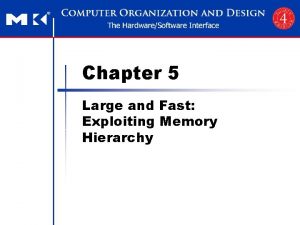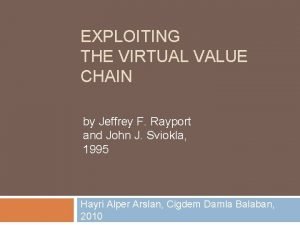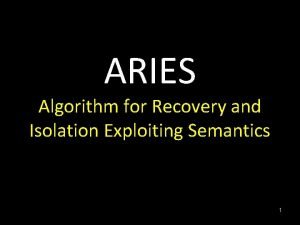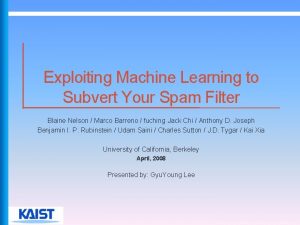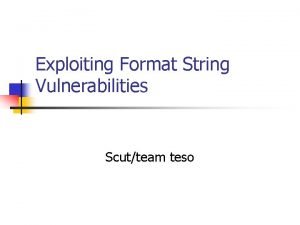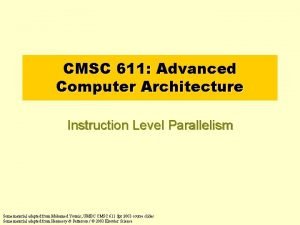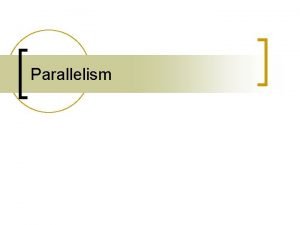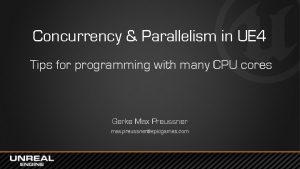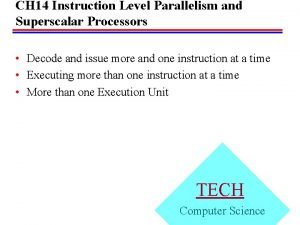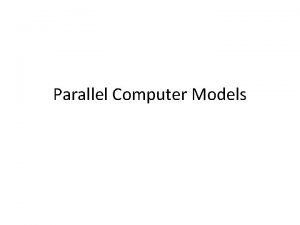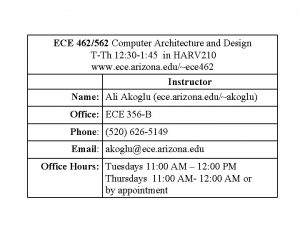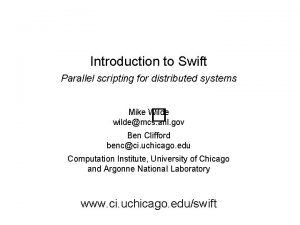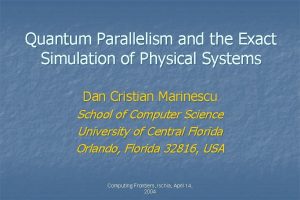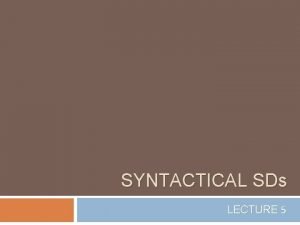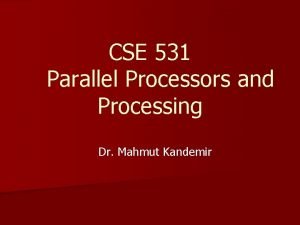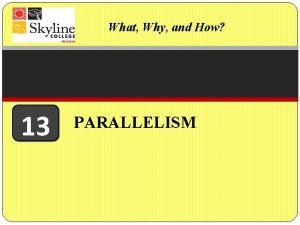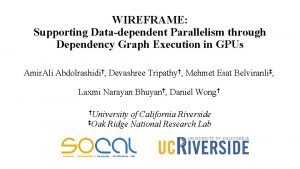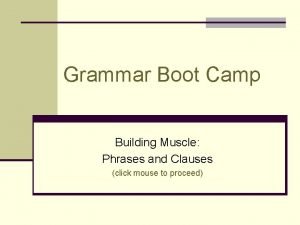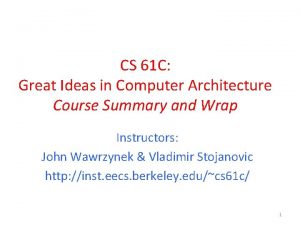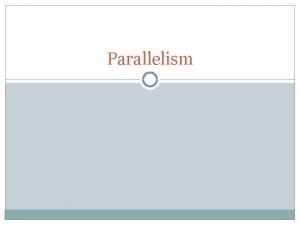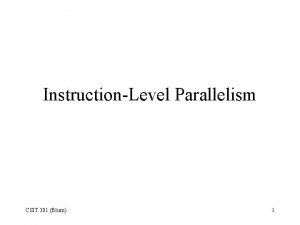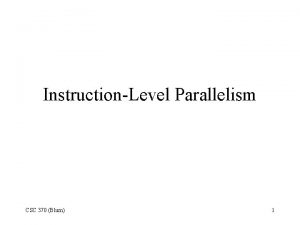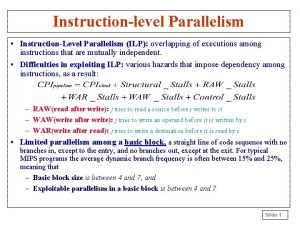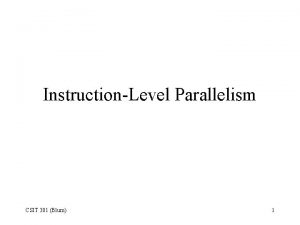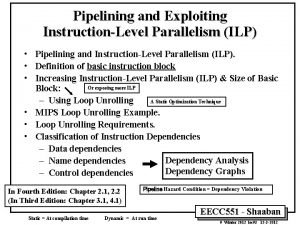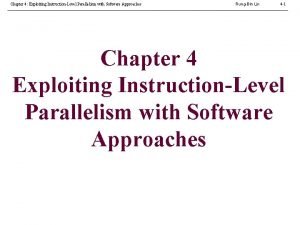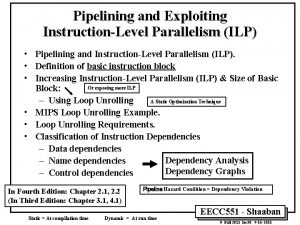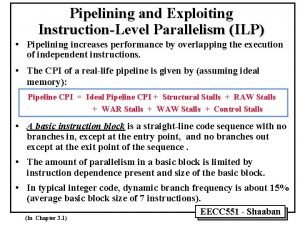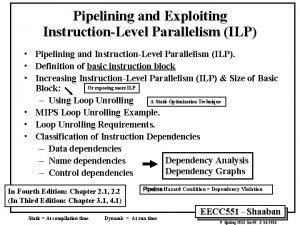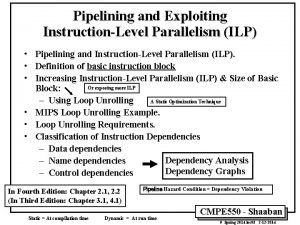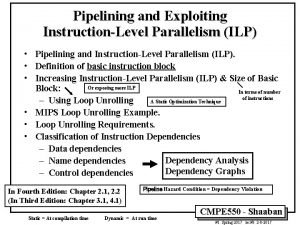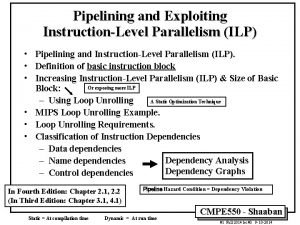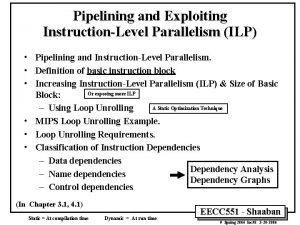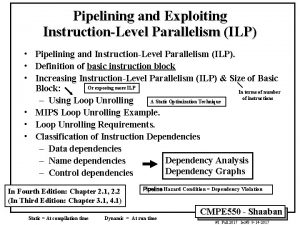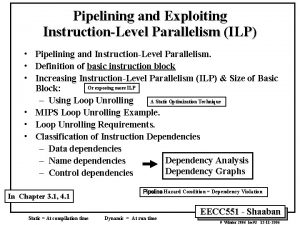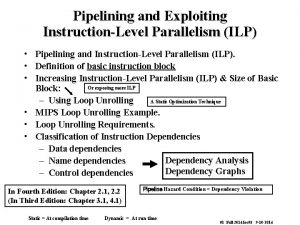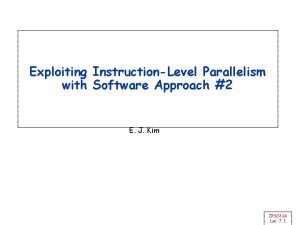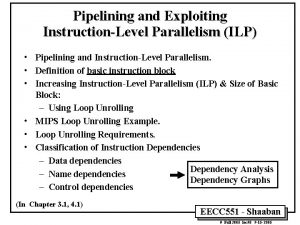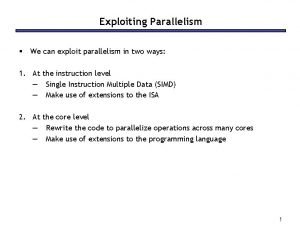InstructionLevel Parallelism n When exploiting instructionlevel parallelism goal











![FP Loop: Where are the Hazards? for (i=999; i>=0; i=i-1) x[i] = x[i] + FP Loop: Where are the Hazards? for (i=999; i>=0; i=i-1) x[i] = x[i] +](https://slidetodoc.com/presentation_image_h2/8d41e39c15bef5fe65bd6788718de58e/image-12.jpg)









![SW Pipelining Source code: for(i=2; i<n; i++) a[i] = a[i-3] + c; Assembly: dependence SW Pipelining Source code: for(i=2; i<n; i++) a[i] = a[i-3] + c; Assembly: dependence](https://slidetodoc.com/presentation_image_h2/8d41e39c15bef5fe65bd6788718de58e/image-22.jpg)











- Slides: 33


Instruction-Level Parallelism n When exploiting instruction-level parallelism, goal is to maximize IPC (or minimize CPI) n n Pipeline CPI = n Ideal pipeline CPI + n Structural stalls + n Data hazard stalls + n Control stalls Parallelism within basic block is limited n A code sequence: n no branch in except to the entry & no branch out except at the exit Typical size of basic block = 3 -6 instructions Must optimize across branches 2

Data Dependence n Loop-Level Parallelism (plenty in many cases) n n n Unroll loop statically or dynamically Use SIMD (vector processors and GPUs) Challenges: n Data dependency n Instruction j is data dependent on instruction i if n n n Instruction i produces a result that may be used by instruction j Instruction j is data dependent on instruction k and instruction k is data dependent on instruction i Dependent instructions cannot be executed simultaneously 3

Getting CPI below 1 (superscalar) n n CPI ≥ 1 if issue only 1 instruction every clock cycle Multiple-issue processors come in 3 flavors: n n n statically-scheduled superscalar processors, dynamically-scheduled superscalar processors, and VLIW (very long instruction word) processors Also, Vector, SIMD… 2 types of superscalar processors issue varying numbers of instructions per clock n n use in-order execution if they are statically scheduled, or n out-of-order execution if they are dynamically scheduled VLIW processors, issue a fixed number of instructions formatted either as one large instruction or as a fixed instruction packet with the parallelism within instructions explicitly indicated by the instruction (Intel/HP Itanium) 4

Static Multiple Issue n n Issue >1 instructions per cycle (multiple parallel pipelines) Examine all the dependencies among the instructions in the bundle If no dependencies exist in bundle, execute If there are, issue only independent Easier/cheaper n Limit the classes of instructions that can be parallel n i. e. one FP, one scalar, etc 5

Static Multiple Issue 6

Example Loop: LD R 2, 0(R 1) DADDIU R 2, #1 SD R 2, 0(R 1) DADDIU R 1, #8 BNE R 2, R 3, LOOP ; R 2=array element ; increment R 2 ; store result ; increment pointer ; branch if not last element 7

Getting CPI < 1: Issuing Multiple Instructions/Cycle n Superscalar MIPS: 2 instructions, 1 FP & 1 anything – Fetch 64 -bits/clock cycle; Int on left, FP on right – Can only issue 2 nd instruction if 1 st instruction issues – More ports for FP registers to do FP load & FP op in a pair Type Int. instruction. IF FP instruction Int. instruction FP instruction n Pipe Stages ID EX MEM IF ID EX IF ID IF WB MEM EX EX ID WB WB MEM WB EX MEM WB 1 cycle load delay expands to 3 instructions in SS n instruction in right half can’t use it, nor instructions in next slot 8

Multiple Issue Details n issue packet: group of instructions from fetch unit that could potentially issue in 1 clock n n n If instruction causes structural or a data hazard either due to earlier instruction in execution or to earlier instruction in issue packet, then instruction cannot issue 0 to N instruction issues per clock cycle, for N-issue Performing issue checks in 1 cycle could limit clock cycle time: O(n 2 -n) comparisons n n n => issue stage usually split and pipelined 1 st stage decides how many instructions from within this packet can issue, 2 nd stage examines hazards among selected instructions and those already been issued => higher branch penalties => prediction accuracy important 9

Multiple Issue Challenges n While Integer/FP split is simple for the HW, get CPI of 0. 5 only for programs with: n n Exactly 50% FP operations AND No hazards If more instructions issue at same time, greater difficulty of decode and issue: n n Even 2 -scalar => examine 2 opcodes, 6 register specifiers, & decide if 1 or 2 instructions can issue; (N-issue ~O(N 2 -N) comparisons) Register file: need 2 x. N reads and 1 x. N writes/cycle Rename logic: must be able to rename same register multiple times in one cycle (multiple registers too)! Consider 4 -way issue: add r 1, r 2, r 3 add p 11, p 4, p 7 sub r 4, r 1, r 2 sub p 22, p 11, p 4 lw r 1, 4(r 4) lw p 23, 4(p 22) add r 5, r 1, r 2 add p 12, p 23, p 4 Imagine doing this transformation in a single cycle! Result buses: Need to complete multiple instructions/cycle n n So, need multiple buses with associated matching logic at every reservation station. Or, need multiple forwarding paths 10

Compiler Techniques for Exposing ILP n Pipeline scheduling n n Separate dependent instruction from the source instruction by the pipeline latency of the source instruction Example: for (i=999; i>=0; i=i-1) x[i] = x[i] + s; 11
![FP Loop Where are the Hazards for i999 i0 ii1 xi xi FP Loop: Where are the Hazards? for (i=999; i>=0; i=i-1) x[i] = x[i] +](https://slidetodoc.com/presentation_image_h2/8d41e39c15bef5fe65bd6788718de58e/image-12.jpg)
FP Loop: Where are the Hazards? for (i=999; i>=0; i=i-1) x[i] = x[i] + s; To simplify assume: n 8 is lowest address n R 1 = base address of X n F 2 = s Loop: L. D F 0, 0(R 1) ; F 0=vector element ADD. D F 4, F 0, F 2 ; add scalar from F 2 S. D 0(R 1), F 4 ; store result DADDUI R 1, -8 ; decrement pointer 8 B(DW) BNEZ R 1, Loop ; branch R 1!=zero 12

FP Loop Showing Stalls 1 Loop: L. D 2 stall 3 ADD. D 4 stall 5 stall 6 S. D 7 DADDUI 8 stall 9 BNEZ F 0, 0(R 1) ; F 0=vector element F 4, F 0, F 2 ; add scalar in F 2 0(R 1), F 4 ; store result R 1, -8 ; decrement pointer 8 B (DW) ; assumes can’t forward to branch R 1, Loop ; branch R 1!=zero Cost: 9 clock cycles Can we rewrite the code to minimize stalls? 13

Revised FP Loop Minimizing Stalls Swap DADDUI and S. D by changing address of S. D 1 Loop: L. D F 0, 0(R 1) 2 DADDUI R 1, -8 3 ADD. D F 4, F 0, F 2 4 stall 5 stall 6 S. D 8(R 1), F 4 ; fix offset after DADDUI 7 BNEZ R 1, Loop 7 clock cycles: 3 for execution (L. D, ADD. D, S. D) and 4 for loop overhead. How to make faster? 14

Unroll Loop Four Times (Simple way) 1 Loop: L. D F 0, 0(R 1) 3 ADD. D F 4, F 0, F 2 6 S. D 0(R 1), F 4 7 L. D F 6, -8(R 1) 9 ADD. D F 8, F 6, F 2 12 S. D -8(R 1), F 8 13 L. D F 10, -16(R 1) 15 ADD. D F 12, F 10, F 2 18 S. D -16(R 1), F 12 19 L. D F 14, -24(R 1) 21 ADD. D F 16, F 14, F 2 24 S. D -24(R 1), F 16 25 DADDUI 26 BNEZ R 1, LOOP 1 cycle stall ; drop DSUBUI & BNEZ 2 cycles stall Rewrite loop to minimize stalls? ; drop DSUBUI & BNEZ R 1, #-32 ; alter to 4*8 Assumes R 1 is multiple of 4: 14 instructions vs 28! 27 clock cycles, or 6. 75 per iteration 15

Unrolled Loop That Minimizes Stalls 1 Loop: L. D F 0, 0(R 1) 2 L. D F 6, -8(R 1) No stalls? 3 L. D F 10, -16(R 1) 4 L. D F 14, -24(R 1) 5 ADD. D F 4, F 0, F 2 6 ADD. D F 8, F 6, F 2 7 ADD. D F 12, F 10, F 2 8 ADD. D F 16, F 14, F 2 9 S. D 0(R 1), F 4 10 S. D -8(R 1), F 8 11 S. D -16(R 1), F 12 12 DSUBUI R 1, #32 13 S. D 8(R 1), F 16 ; 8 -32 = -24 14 BNEZ R 1, LOOP 14 instructions, 14 clock cycles, or 3. 5 per iteration 16

Unrolled Loop Details n n n Do not usually know upper bound of loop Suppose it is n, and we would like to unroll the loop to make k copies of the body Instead of a single unrolled loop, we generate a pair of consecutive loops: n n n 1 st executes (n mod k) times and has a body that is the original loop 2 nd is the unrolled body surrounded by an outer loop that iterates (n/k) times For large values of n, most of the execution time will be spent in the unrolled loop Called “Strip mining” Versioning the code: different sequences for different cases/conditions/… 17

5 Loop Unrolling Decisions Requires understanding how one instruction depends on another and how the instructions can be changed or reordered given the dependences: n n n Determine loop unrolling useful by finding that loop iterations were independent (except for maintenance code) Use different registers to avoid unnecessary constraints forced by using same registers for different computations Eliminate the extra test and branch instructions and adjust the loop termination and iteration code Determine that loads and stores in unrolled loop can be interchanged by observing that loads and stores from different iterations are independent • Transformation requires analyzing memory addresses and finding that they do not refer to the same address Schedule the code, preserving any dependences needed to yield the same result as the original code 18

3 Limits to Loop Unrolling 1) Decrease in amount of overhead amortized with each extra unrolling n Remember Amdahl’s Law 2) Growth in code size n n For larger loops, it increases the instruction cache miss rate Code size important for embedded devices 3) Register pressure: potential shortfall in registers created by aggressive unrolling and scheduling n n If not possible to allocate all live values to registers, may lose some or all of its advantage Loop unrolling reduces impact of branches on pipeline; another way is branch prediction 20

Another possibility: Software Pipelining n n Observation: if iterations from loops are independent, then can get more ILP by taking instructions from different iterations Software pipelining: reorganizes loops so that each iteration is made from instructions chosen from different iterations of the original loop 21

S/W Pipelining: prolog/epilogue for i = 1 to bignumber A(i) B(i) C(i) End Prologue: A(1), A(2), B(1) for i = 1 to (bignumber – 2) A(i+2) B(i+1) C(i) End Epilogue: B(10) C(9), C(10) Main loop body very small! Assume: A, B, C independent 22
![SW Pipelining Source code fori2 in i ai ai3 c Assembly dependence SW Pipelining Source code: for(i=2; i<n; i++) a[i] = a[i-3] + c; Assembly: dependence](https://slidetodoc.com/presentation_image_h2/8d41e39c15bef5fe65bd6788718de58e/image-22.jpg)
SW Pipelining Source code: for(i=2; i<n; i++) a[i] = a[i-3] + c; Assembly: dependence spans three iterations “distance = 3” Pipeline kernel 1 cycle load add store incra 3 incra loada add store incra 3 incra Initiation Interval (II) load add store incra 3 incra 23

Software Pipelining Example Symbolic Loop Unrolling – – – After: Software Pipelined 1 S. D 0(R 1), F 4 ; 2 ADD. D F 4, F 0, F 2 ; 3 L. D F 0, -16(R 1); 4 DSUBUI R 1, #8 5 BNEZ R 1, LOOP overlapped ops Before: Unrolled 3 times 1 L. D F 0, 0(R 1) 2 ADD. DF 4, F 0, F 2 3 S. D 0(R 1), F 4 4 L. D F 6, -8(R 1) 5 ADD. DF 8, F 6, F 2 6 S. D -8(R 1), F 8 7 L. D F 10, -16(R 1) 8 ADD. DF 12, F 10, F 2 9 S. D -16(R 1), F 12 10 DSUBUI R 1, #24 11 BNEZ R 1, LOOP Stores M[i] Adds to M[i-1] Loads M[i-2] SW Pipeline Time Loop Unrolled Maximize result-use distance Time Less code space than unrolling Fill & drain pipe only once per loop vs. once per each unrolled iteration in loop unrolling 5 cycles per iteration

When Safe to Unroll Loop? n n n Example: Where are data dependencies? (A, B, C distinct & nonoverlapping) for (i=0; i<100; i=i+1) { A[i+1] = A[i] + C[i]; B[i+1] = B[i] + A[i+1]; } /* S 1 */ /* S 2 */ S 2 uses the value A[i+1] computed by S 1 in the same iteration S 1 uses a value computed by S 1 in an earlier iteration, since iteration i computes A[i+1] which is read in iteration i+1. The same is true of S 2 for B[i] and B[i+1] This is a “loop-carried dependence”: between iterations For the previous example each iteration was distinct Implies that iterations can’t be executed in parallel, right? ? 25

Loop-carried dependence => no parallelism? n Consider: for (i=0; i< 8; i=i+1) { A = A + C[i]; } Could compute: /* S 1 */ “Cycle 1”: temp 0 = C[0] + C[1]; temp 1 = C[2] + C[3]; temp 2 = C[4] + C[5]; temp 3 = C[6] + C[7]; “Cycle 2”: temp 4 = temp 0 + temp 1; temp 5 = temp 2 + temp 3; “Cycle 3”: A = temp 4 + temp 5; n n Relies on associative nature of “+”. See “Parallelizing Complex Scans and Reductions” by Allan Fisher and Anwar Ghuloum 26

VLIW Processors n Package multiple operations into one instruction n Example VLIW processor: n n n One integer instruction (or branch) Two independent floating-point operations Two independent memory references Memory FP Operation Reference #1 Reference #2 #1 #2 n Integer Operation/Branch Must be enough parallelism in code to fill the available slots 27

VLIW Processors n Disadvantages: n n Statically finding parallelism Code size (store even empty slots) No hazard detection hardware Binary code compatibility? n What happens to the code for a new, bigger, better model? 28

VLIW: Very Large Instruction Word n Each “instruction” explicitly codes multiple operations n n n In IA-64, grouping called a “packet” In Transmeta, grouping called a “molecule” (with “atoms” as ops) Tradeoff instruction space for simple decoding n n n The long instruction word has room for many operations By definition, all the operations the compiler puts in the long instruction word are independent => execute in parallel E. g. , 2 integer operations, 2 FP ops, 2 Memory refs, 1 branch n n 16 to 24 bits per field => 7*16 or 112 bits to 7*24 or 168 bits wide Compiler must schedule across several branches 29

Recall: Unrolled Loop Minimizes Stalls for Scalar 1 Loop: 2 3 4 5 6 7 8 9 10 11 12 13 14 L. D ADD. D S. D DSUBUI BNEZ S. D F 0, 0(R 1) F 6, -8(R 1) F 10, -16(R 1) L. D to ADD. D: 1 Cycle F 14, -24(R 1) ADD. D to S. D: 2 Cycles F 4, F 0, F 2 F 8, F 6, F 2 F 12, F 10, F 2 F 16, F 14, F 2 0(R 1), F 4 -8(R 1), F 8 -16(R 1), F 12 R 1, #32 R 1, LOOP 8(R 1), F 16 ; 8 -32 = -24 14 clock cycles, or 3. 5 per iteration 30

Loop Unrolling in VLIW Memory reference 1 Memory reference 2 L. D F 0, 0(R 1) L. D F 6, -8(R 1) FP operation 1 FP op. 2 Int. op/ branch Clock 1 L. D F 10, -16(R 1) L. D F 14, -24(R 1) 2 L. D F 18, -32(R 1) L. D F 22, -40(R 1) ADD. D F 4, F 0, F 2 ADD. D F 8, F 6, F 2 3 L. D F 26, -48(R 1) ADD. D F 12, F 10, F 2 ADD. D F 16, F 14, F 2 4 ADD. D F 20, F 18, F 2 ADD. D F 24, F 22, F 2 5 S. D 0(R 1), F 4 S. D -8(R 1), F 8 ADD. D F 28, F 26, F 2 6 S. D -16(R 1), F 12 S. D -24(R 1), F 16 7 S. D -32(R 1), F 20 S. D -40(R 1), F 24 DSUBUI R 1, #48 8 S. D -0(R 1), F 28 BNEZ R 1, LOOP 9 Unrolled 7 times to avoid delays 7 results in 9 clocks, or 1. 3 clocks per iteration (1. 8 X) Average: 2. 5 ops per clock, 50% efficiency Note: Need more registers in VLIW (15 vs. 6 in SS) 31

Problems with 1 st Generation VLIW n Increase in code size n n n Operated in lock-step; no hazard detection HW n n n generating enough operations in a straight-line code fragment requires ambitiously unrolling loops whenever VLIW instructions are not full, unused functional units translate to wasted bits in instruction encoding a stall in any functional unit pipeline caused entire processor to stall, since all functional units must be kept synchronized Compiler might predict function units, but caches hard to predict Binary code compatibility n Pure VLIW => different numbers of functional units and unit latencies require different versions of the code 32

Solutions to these Problems n Smaller “packets” that express independence n n n More registers, special registers, compiler techniques n n Code Efficiency (stop early if no independent instructions) Portability (can express too much parallelism that a future implementation can exploit) Better code (utilization) Dynamic decisions n No lock-step, but more complex! 33

Multiple Issue 34
 Instruction level parallelism vs thread level parallelism
Instruction level parallelism vs thread level parallelism Large and fast: exploiting memory hierarchy
Large and fast: exploiting memory hierarchy What is virtual value chain
What is virtual value chain Aries algorithm
Aries algorithm What is new entry in entrepreneurship
What is new entry in entrepreneurship Exploiting machine learning to subvert your spam filter
Exploiting machine learning to subvert your spam filter Exploiting format string vulnerabilities
Exploiting format string vulnerabilities What is a sport/event entity?
What is a sport/event entity? Ilp computer architecture
Ilp computer architecture Parallelism definition literature
Parallelism definition literature Parallelism vs juxtaposition
Parallelism vs juxtaposition Concurrency & parallelism in ue4
Concurrency & parallelism in ue4 Instruction level parallelism
Instruction level parallelism 1 crore in number
1 crore in number Io parallelism
Io parallelism 68000
68000 We found the film repulsive offensive and embarrassing
We found the film repulsive offensive and embarrassing Parallel and non parallel structure
Parallel and non parallel structure Parallelism in a modest proposal
Parallelism in a modest proposal Parallelism definition literature
Parallelism definition literature Quantum parallelism
Quantum parallelism Syntactical stylistic devices
Syntactical stylistic devices Motivating parallelism
Motivating parallelism A parallelism
A parallelism Janapa
Janapa Rhetorical analysis of letter from birmingham jail
Rhetorical analysis of letter from birmingham jail Parallelism
Parallelism Parallel processing architecture
Parallel processing architecture What is parallelism
What is parallelism Parallel structures examples
Parallel structures examples Parallel structures examples
Parallel structures examples Task level parallelism
Task level parallelism Rhetorical devices
Rhetorical devices What is parallelism
What is parallelism

